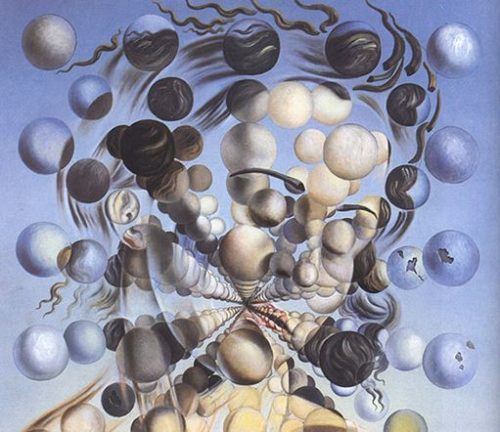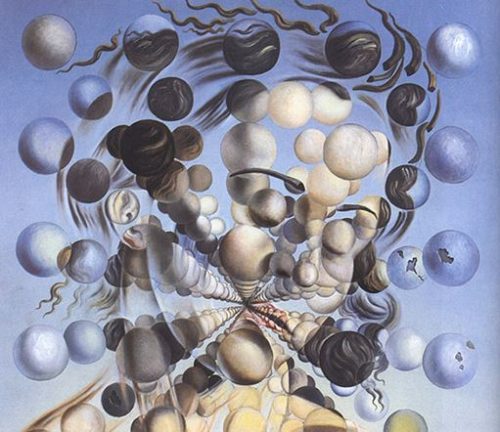Welcome to the fantastical world of Salvador Dali, where mustaches are as eccentric as the imagination itself. Born in the vibrant lands of Spain in 1904, Dali wasn’t just an artist; he was a maestro of the bizarre, a pioneer of the surreal. His most mesmerizing creation? Galatea of the Spheres.
Who was Salvador Dali?

Imagine a guy with a mustache so wild it could have its own zip code—that’s Dali. Born in 1904, he rocked the art world with his unique take on things. Surrealism was his jam, a movement all about dreams and the wild stuff our brains cook up when we’re not looking.
Dali wasn’t your run-of-the-mill painter; he was an art rebel. His famous artworks, like The Persistence of Memory, messed with reality, challenging how we see the world. He didn’t just stick to a style; he mixed it up. He hung out with other art rebels, made movies, and created more work. The guy even had a thing for Freudian psychology, exploring the mysteries of the mind in his art.
His Career

Dali’s journey wasn’t your typical art story. It wasn’t just about paint on canvas; it was about turning the ordinary into the extraordinary. He created a visual language that spoke to the surreal, making dreams tangible on the canvas.
Now, Galatea of the Spheres isn’t your everyday painting. Dali didn’t just paint Gala, his wife; he turned her into a cosmic spectacle. Imagine a Gala made up of floating, see-through bubbles. Wild, right?
What’s Happening in Galatea of the Spheres?

| Artist | Salvador Dali |
| Date Painted | 1952 |
| Medium | Oil on Canvas |
| Genre | Surrealism |
| Period | Post-war |
| Dimensions | 65.0 cm × 54.0 cm (25.6 in × 21.3 in) |
| Series / Versions | Not applicable |
| Where is it housed? | Gala-Salvador Dali Foundation, Figueres, Spain |
So, it’s 1952, and Dali’s got atomic fever. In Galatea of the Spheres, Gala, his leading lady, isn’t just a regular gal. She’s this dreamy, cubist creation made of crystal-clear spheres. Think of it as a dance between Gala and the tiny building blocks of the universe.
The painting isn’t just about looking cool; it’s Dali’s way of saying, “Hey, let’s blend art and science.” Gala’s floating in a sea of spheres, making us question where reality ends and dreams begin.
Now, let’s dive deeper into the mesmerizing details of Galatea of the Spheres.
The Intricacies of Galatea of the Spheres
Imagine Gala suspended in a celestial ballet, her form a kaleidoscope of spheres. Dali’s meticulous attention to detail is nothing short of mind-boggling. Each sphere is carefully crafted, each angle thoughtfully considered. It’s not just art; it’s a symphony of shapes and shadows.
The use of spheres is more than just a visual feast. It’s a nod to the atomic and subatomic particles that fascinated Dali. While the world was still reeling from the impact of atomic discoveries, Dali took inspiration from the science of the small, weaving it into the fabric of his surreal universe.
The Cubist influence is unmistakable. Gala isn’t just a static portrait; she’s a dynamic interplay of fragments, each piece a puzzle forming the whole. Dali takes Cubism and turns it on its head, injecting it with a surreal elixir that transforms the familiar into the extraordinary.
It’s not just a painting; it’s a journey into the surreal mind of Salvador Dali. Gala, rendered in translucent spheres, becomes a cosmic entity, a muse transformed into an otherworldly spectacle. The colors, the shapes, the ethereal glow—each element invites us to question the boundaries of reality.
Cool Facts about the Painting
Science Geek Alert: Dali was all about science, especially atomic stuff. Galatea of the Spheres is like a painting straight out of a science class, but way cooler.
Cubism with a Twist: Gala’s not just sitting there; she’s made up of floating bubbles. It’s like Dali took cubism, shook it up, and added a splash of surreal magic.
Gala, the Muse: Dali’s wife, Gala, wasn’t just a pretty face. She was his muse, inspiring him to create mind-bending art. In Galatea of the Spheres, she’s the star of the show.
Artistic Perfection:Dali didn’t just throw this painting together. Every sphere is perfectly placed. It’s like he’s showing off his art ninja skills.
Legacy of Weirdness: Galatea of the Spheres isn’t just a painting; it’s a legacy. Dali left his mark on art, making us rethink the boundaries between reality and imagination.
The Legacy of Galatea of the Spheres
Beyond its aesthetic allure, Galatea of the Spheres is a testament to Dali’s ability to blur the lines between art and science. It’s not just a painting; it’s a bridge between the tangible and the abstract, a visual journey into the surreal recesses of Dali’s mind.
The painting’s legacy extends beyond the canvas. Dali’s fusion of artistic brilliance and scientific curiosity paved the way for a new understanding of the relationship between art and the atomic age. Galatea of the Spheres is a visual symphony that continues to resonate, challenging us to explore the intersection of imagination and scientific inquiry.
Frequently Asked Questions
What does Galatea of the Spheres symbolize?
The bust of Gala is shown in the picture as a matrix of spheres that appear to be suspended in space. With the spheres themselves standing in for atomic particles, it symbolizes the ultimate discontinuity of matter and is a synthesis of Renaissance art and atomic physics.
What is Galatea of the Spheres inspired by?
One of Dalí’s many pictures of his wife, Galatea of the Spheres shows her head and shoulders broken into spheres that appear to float in space. The disintegration reflects Dalí’s preoccupation with nuclear physics and the realization that atoms make up matter at the time.
Conclusion
In a nutshell, Salvador Dali’s Galatea of the Spheres isn’t just a painting; it’s a trip into the surreal. It’s Dali saying, “Why can’t art be a bit weird and a bit scientific?” Dive in, and let your mind float in a sea of spheres. Let Gala’s dance with the atomic inspire you to question the ordinary and embrace the extraordinary. After all, in Dali’s universe, the surreal is just a brushstroke away from reality.













